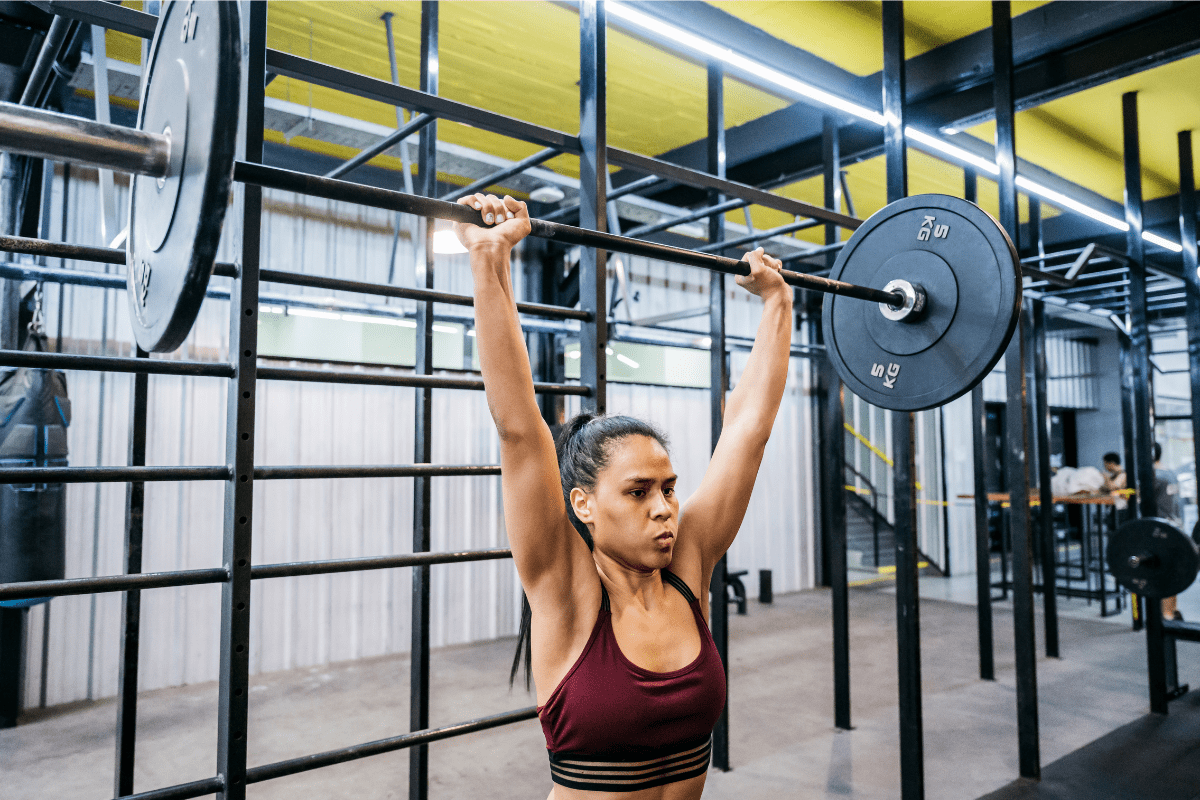13 Best Overhead Press Alternatives for Shoulder Strength
The Overhead Press should be a staple in anyone’s training program. It’s a big compound movement, meaning it uses multiple muscle groups simultaneously, it’s done on the feet and the core has to work to stabilize the torso through the movement.
However, sometimes you may find yourself needing an alternative for Overhead Presses.
Maybe you don’t have a barbell or maybe you’re just looking to add some variety to your workouts.
Whatever the reason, if you’re looking for an exercise to substitute for Overhead Press then you’re in the right place. I’m about to share with you 13 of my favorite overhead press alternatives including different variations and different equipment.
Key Takeaways
Best Overhead Press Alternative for…
- Power Development: Push Press
- Using Dumbbells: Dumbbell Shoulder Press
- Adding Variety: Landmine Press
- Beginners: Dumbbell Shoulder Press
- No Weights: Handstand Push-ups
Overhead Press Alternatives
The first few Overhead Press alternatives below still utilize a barbell, just in different variations or starting positions.
The rest of the exercises incorporate different pieces of equipment like dumbbells, kettlebells or just your own bodyweight.
Push Press
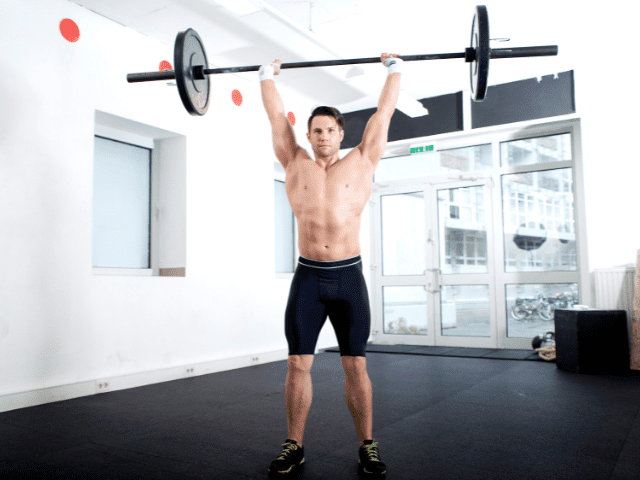
I’ve been a college sports performance coach for almost 20 years, so of course, my first suggestion would be an alternative that turns the overhead press into a power movement.
The Push Press is essentially an Overhead Press that involves generating power from the hips and legs to help drive the barbell overhead. This changes the movement from simply a shoulder strength-building exercise to more of a total body power development exercise.
The Push Press can also work as the first movement in a progression of overhead power movements like Power Jerk and Split Jerk.
Step-by-Step Instructions
- Set the barbell at the height you would normally front squat with. (Barbell 1-2 inches below the flexed elbow, still on the hooks).
- Grab the barbell with your index finger on the knurling or just outside the knurling. (Flexibility and what feels comfortable are important here).
- Flex the elbows up slightly and keep your knuckles fairly vertical to the ceiling.
- You are not taking a “Front rack” position here. The elbows will be slightly up but the bar is not resting on the anterior delts.
- To unrack the bar, take a deep breath and brace the abdominal muscles and upper back. Use a staggered stance to unrack the bar.
- Take 2 steps backward and be sure that you will not hit the hooks or anything above your head when you start to press.
- Initiate the movement with a “dip” or bend of the knee that will help you propel the barbell up with momentum. Do not bend the knee forward onto the toes.
- Think about how you initiate a squat. The knee bend should be very similar to this movement.
- This is a quick movement that helps get the barbell moving upward.
- As you extend the legs, push the barbell up. Be sure not to hit your chin. Lock the rep out by holding the barbell overhead for about 1 second.
- Slowly bring the barbell back down to prepare for the next repetition.
Coaching Points
The push press is a compound movement specific to Olympic lifts and powerlifting (depending on the event).
This is also a great movement for field and court sport athletes that need overhead strength and power. This movement should be trained and programmed according to goals, injury history, athlete readiness, and time of year.
Floor Overhead Press
The Floor Overhead Press, also known as a Z Press, is one of my favorite alternatives for Floor Press for a few reasons.
First, the overhead pressing motion doesn’t change. You’re still bringing the bar down to your shoulders and pressing overhead.
However, it completely takes the legs out of the equation. No cheating to help get up reps.
It also makes the core have to work incredibly hard to keep yourself upright. With nothing to brace your back against and no legs available for balance, it’s all on your core to keep yourself upright. And this is something you’ll realize immediately on rep number one.
Finally, it will also completely expose hamstring flexibility issues. If you have very tight hamstrings, just keeping yourself upright is going to be an incredible challenge. If this is you, it’s time to address those tight hammys.
How To
- Sit on the floor in front a rack, legs straight out in front.
- Brace the core and unrack the bar (or have a partner hand it to you).
- Make sure you’re posture is good and your core is tight before trying to press.
- Press the bar to full extension overhead.
- Lower the bar back down to under the chin and repeat until all reps are completed.
Coaching Points
The Z Press demands some hamstring flexibility and core stability to maintain the body position while pressing. Deficits in either of these areas will greatly hinder your ability to be able to do Z Presses.
Once the bar crosses the top of the head, ‘pull the head through’ so that you’re pressing the bar directly over the ears.
Curl and Press
Curl and Press turns the Overhead Press into a combo movement with Barbell Curls.
Coaching Tip: Yes, Curl and Press is more popularly done with dumbbells, but it can absolutely be done with a barbell.
If using a bar, keep your underhand grip, curl and then press vertically with that same grip. You probably won’t be able to get the bar completely overhead, but you’ll definitely know that your shoulders are working.
How To
- Start by standing upright with your feet shoulder-width apart. Hold a dumbbell in each hand with your arms fully extended and palms facing forward.
- Curl the dumbbells toward your shoulders by flexing your biceps. Keep your elbows close to your torso throughout the motion.
- Once the dumbbells are at shoulder level, rotate your wrists so that your palms are facing forward, getting ready for the press.
- Press the dumbbells upwards, extending your arms until they are fully extended. Aim to position the dumbbells directly above your shoulders.
- Briefly hold the dumbbells at the peak of the movement, making sure not to lock your elbows.
- Reverse the press by lowering the dumbbells back to shoulder level.
- Rotate your wrists back to face you and lower the dumbbells back to the starting position, extending your arms fully.
Bench Press
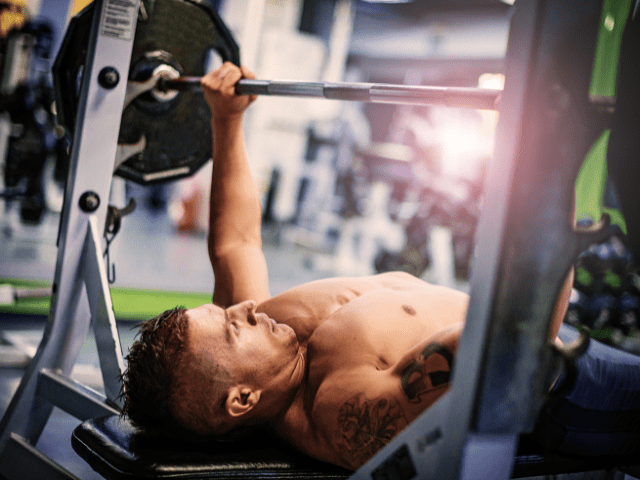
Bench Press isn’t a vertical pressing movement like most of the other Overhead Press alternatives I have listed, but it doesn’t make any sense to not include it.
If we’re talking about building upper body mass and developing pressing strength Bench Press is still the number one draft pick. Improve your Bench Press and there is a good chance your overhead strength will follow along.
Step-by-Step Instructions
- Set the height of the barbell so that when you unrack the barbell, you are only doing a very short upward concentric movement.
- Lie flat on your back on the bench.
- Keep your feet flat on the floor. (Some do find it comfortable to pull the feet back toward their butt as they arch).
- Keep your butt on the bench.
- Pull your shoulder blades together and keep the back of your head on the bench. You will slightly arch your back. Keep your core tight and keep the shoulder blades pulled back tight.
- Take a thumbs-width grip from the knurling and completely close your grip. Keep your knuckles pointing toward the ceiling and squeeze the barbell.
- Later in this article, I will go over other popular grips and why they are used.
- Unrack the weight and take a deep breath.
- Control the barbell down during the eccentric movement and draw the barbell in, keeping the elbows at about a 45-degree angle away from the torso.
- The barbell will make contact with your torso right at the nipple line on the chest.
- Once contact is made, drive the barbell back up to the starting position.
Coaching Points
Always have a spotter, regardless of the weight. Yes, even for the lighter sets.
When you bring the bar down, lightly tap the chest and then press back up. Do NOT bounce it. I can’t tell you how many guys I’ve watched Bench Press like they were mad at their sternum.
In regards to your setup and form; treat every rep like it’s a 1 rep max. Put a tremendous amount of detail in your setup (Do it the exact same way, every rep)
Make small gains in weight over time.
Incline Bench Press
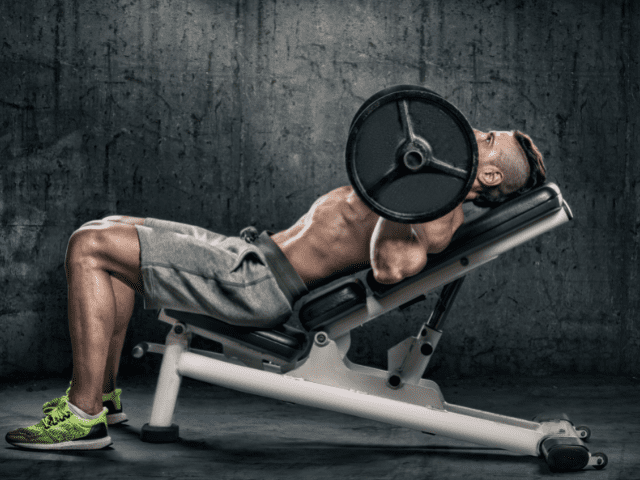
It’s hard to mention Bench Press and not also include Incline Bench Press, especially since Incline Bench is closer to being a vertical press and gets the shoulder muscles more involved than flat bench.
This probably goes without saying, but I’ll go ahead and mention it anyway. Don’t forget that both Bench Press and Incline Bench Press can also both be done with dumbbells if you don’t have a barbell available to you.
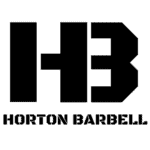
Tired of coming up with your own workouts? But don’t want to pay an arm and a leg?
I post workouts 5 days a week right here. (Did I mention they’re free?)
Landmine Press
The Landmine Press is another overhead press alternative that uses the barbell but in a much different way. Before you scroll right past this one because you don’t have a landmine attachment, here’s how you can create your own landmine press with just a tennis ball.
Load your barbell on the open end, bring the bar up to your shoulder and then – using a single arm – press the bar overhead.
If variety is what you came here looking for, the Landmine Press is definitely one of the best shoulder press alternatives.
How To
- Setup a landmine attachment with a barbell.
- Grab the end of the barbell and start with it at chest level.
- Feet should be shoulder-width apart with knees slightly bent and core braced.
- Remove one hand from the bar and then press the bar to full extension with the other arm.
- Lower the bar back to chest level under control.
- Repeat until all reps are completed and then switch to the opposite arm.
Coaching Points
What I’ve described in the instructions above is basically a strict overhead press. However, you can also use Landmine Presses as a more dynamic movement involving the hips – similar to a Push Press.
Keep the core braced and maintain a neutral torso. If you find yourself leaning back and arching the low back, lower the weight if needed and correct your form.
Dumbbell Shoulder Press
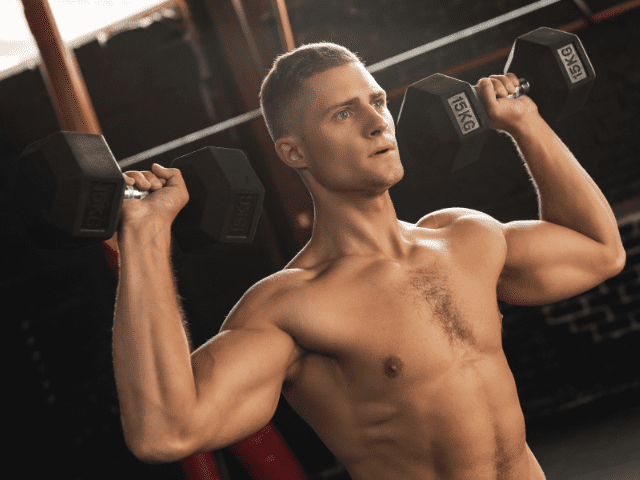
If you don’t have access to a barbell, my first suggestion would be to substitute Dumbbell Shoulder Press. They can be done seated or standing, but I prefer using a standing position. (With athletes I will also choose an exercise that can be done on the feet rather than sitting.)
The overhead pressing movement itself doesn’t change. Having said that, using dumbbells does make it a little easier to find a pressing path that is most comfortable for your shoulders. If you have prior shoulder injuries that make overhead pressing with a barbell uncomfortable, using dumbbells could be a better option.
If you do decide to go with the seated dumbbell shoulder press variation, avoid overarching which will place extra strain on the low back.
Arnold Press
Arnold Press is a popular dumbbell shoulder press variation made popular by, you guessed it, Arnold Schwarzenegger.
In this variation, start with the dumbbells almost right in front of your face with your palms facing you. Press up and out, moving the dumbbells in an oval shape towards overhead extension. As you press, you will also rotate your palms forward so that they move 180 degrees from the bottom of the rep to the top.
If you’ve never done Arnold Presses before, they’re definitely a great exercise that can add some variety to your workout routine.
Kneeling Single Arm Press
The Kneeling Single Arm Dumbbell Press works pretty much as it sounds. Take a kneeling position on one knee, with a dumbbell in the opposite hand.
This pressing variation has some of the same benefits as the Floor Overhead Press. The legs are removed from the lift in the kneeling position and balance plays an important role being a single arm movement.
Handstand Push Up
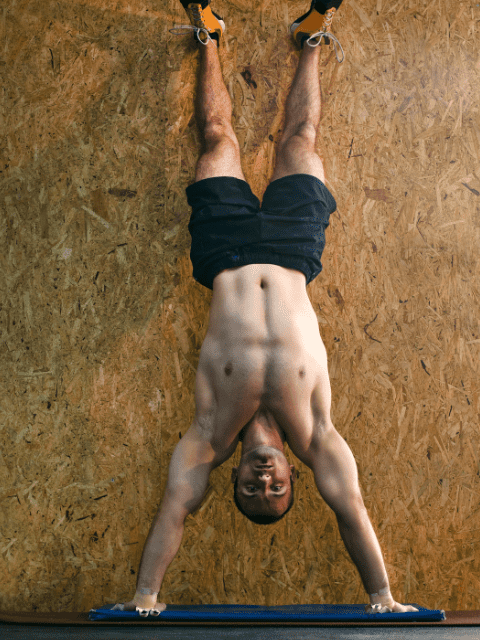
Easily one of the hardest bodyweight exercises to perform, Handstand Push-Ups will test your shoulder strength, shoulder stability, core and coordination all in one movement. Because it’s a bodyweight movement, it has the advantage of being able to be done anywhere without the need for equipment.
Find a sturdy wall, place your hands a few inches away and then kick your feet up over your head against the wall. From here, lower yourself down until you almost touch the floor with your head and then press yourself back up.
Note: Handstand Push-ups are an ADVANCED movement. I would not suggest this for beginners as it can be dangerous if you don’t have sufficient shoulder and core strength.
Machine Shoulder Press
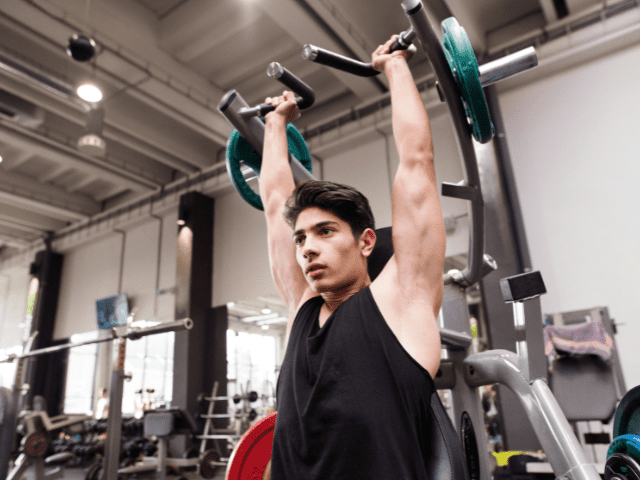
If you’re working out in a commercial gym or college weight room and you have access to machines, a Machine Shoulder Press can be a solid overhead press alternative.
My favorite machine for this is the Hammer Strength Iso Shoulder Press. It’s plate-loaded so it works more like a free weight and less like a cable machine. Both shoulders also work independently of one another too, so like with dumbbells, if you have any strength imbalances they’ll show themselves.
Dumbbell Side Raise

Admittedly, Dumbbell Side Raises would not be my first choice for an Overhead Press Alternative. It’s not a pressing movement, but it is an exercise that will work the shoulders.
If you find yourself in an environment (I’m thinking a hotel gym here) where you’re limited in equipment to light dumbbells, Dumbbell Side Raises may work perfectly in that kind of situation.
Pro Tip: Do NOT lock your arms out while doing Side Raises. Keep a slight bend in the elbow to keep unnecessary strain off of the elbow joint.
Med Ball Power Jerk
Let’s finish where we started with a power-focused alternative to Overhead Presses. This is similar to the Push Press where you’ll utilize your hips and legs to dip and drive the medicine ball up.
The biggest difference with Med Ball Power Jerks though is that you’ll drive all the way through the movement releasing the ball in the air at the top. No need to worry about staying under control as with a barbell which is one of the biggest benefits of using a med ball that you can throw into the air.

Get Shredded… For Free
Get a free workout Monday through Friday, posted right here on Horton Barbell. These workouts are designed to help you get strong, in shape and look great at the beach!
Final Thoughts
Overhead Press is a beast of an exercise for developing strong shoulders, but sometimes Overhead Presses just aren’t an option.
You may not have the proper equipment available to you, maybe you have a low ceiling, or perhaps you’re just looking to add some variety to your barbell overhead press routine.
In these situations, you’ll need an overhead press alternative and I hope that one of the exercises I’ve listed here fits what you were looking for.

